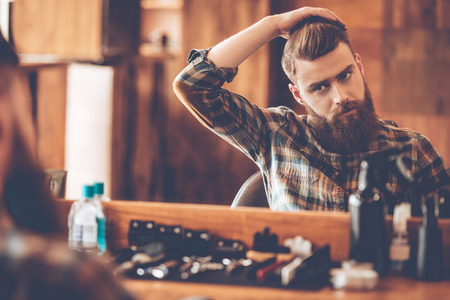Introduction to Aftershaves in Britain
When it comes to men’s grooming in the UK, aftershave holds a special place in the daily routine. Far from being just a finishing touch, aftershave has its roots deeply embedded in both British history and culture. Traditionally applied after shaving, its original purpose was not only to soothe the skin but also to disinfect any small nicks or cuts—a crucial step in the days before modern razors and antiseptics. Over time, aftershave evolved into a symbol of refinement and self-care for British men, becoming almost as essential as the shave itself.
In Britain, aftershave quickly became more than just a functional product; it grew into an expression of personal style and social status. From the bustling barbershops of Victorian London to the contemporary high street chemists, aftershave has maintained its relevance by adapting to changing tastes and technologies. The table below highlights key moments in the evolution of men’s aftershave within British culture:
| Era | Key Development | Cultural Impact |
|---|---|---|
| Victorian Era | Alcohol-based splashes introduced | Marked sophistication; linked with hygiene |
| Post-War Britain | Milder formulas & branded fragrances emerge | Became a daily ritual; status symbol among men |
| Modern Day | Focus on skincare ingredients and diverse scents | Personalised grooming; reflects individuality |
This rich history demonstrates why aftershave is more than just an accessory—it’s a British grooming staple shaped by centuries of tradition and evolving trends.
2. The Victorian Gentleman: Early Days of Aftershave
As we step back into the 19th century, the landscape of men’s grooming in Britain was being quietly revolutionised. The Victorian era marked a significant turning point—British gentlemen began to embrace aftershaves not just as a post-shave necessity, but as an essential marker of refinement and social status. During this period, aftershaves were crafted using a variety of natural ingredients and botanicals, often sourced from British gardens and colonial imports.
Ingredients & Scents in Victorian Aftershaves
The concoctions that graced the dressing tables of well-heeled gentlemen were far from today’s mass-produced blends. Instead, they relied heavily on traditional ingredients with both practical and olfactory appeal. Below is a table showcasing some popular ingredients and their associated scents:
| Ingredient | Scent Profile | Purpose |
|---|---|---|
| Rosewater | Floral, delicate | Soothing skin irritation |
| Bergamot oil | Citrusy, fresh | Antiseptic, uplifting fragrance |
| Bay rum | Spicy, woody | Toning and refreshing |
| Lavender | Herbal, calming | Healing cuts and nicks |
The Social Significance of Scent
The ritual of applying aftershave wasn’t merely about personal hygiene; it was deeply woven into the fabric of Victorian society. A gentleman’s choice of aftershave signalled his taste, social standing, and even his worldliness. It was common for bespoke barbers in London’s West End to craft signature scents for their clients—unique blends that would become part of a man’s identity.
Cultural Impact on Daily Life
In an era when first impressions mattered immensely, a subtle yet distinctive aftershave could speak volumes before a word was uttered. Whether attending a formal dinner or heading to the local club, British men began to understand the quiet power of scent. This newfound appreciation laid the groundwork for the diverse aftershave culture we see in Britain today.

3. Post-War Changes and the Rise of Commercial Brands
After the Second World War, mens grooming in Britain underwent a dramatic transformation, especially when it came to aftershaves. The austerity of wartime rationing gave way to a period of optimism and modernisation. With British society eager to embrace new trends and technologies, personal care became a symbol of sophistication and social mobility. It was during this era that aftershave production truly boomed, as commercial brands began to recognise the potential of marketing directly to men.
Major British companies seized the opportunity to shape post-war masculinity. Advertising campaigns moved away from strictly functional messages—such as “soothes the skin”—and started tapping into aspirational themes: confidence, status, and even romance. Department stores like Harrods and Boots became hubs for stylish blokes looking to upgrade their bathroom shelves. And lets not forget the surge of TV adverts in the ‘50s and ‘60s: suddenly, every man wanted a signature scent.
Iconic British Aftershave Brands |
Year Established |
Key Contributions |
|---|---|---|
| Yardley | 1770 (but aftershaves popularised post-WWII) | Brought refined scents to a wider audience; classic lavender aftershave became a staple |
| Brut | 1965 | Launched with bold advertising targeting the modern British man; endorsed by sports legends like Henry Cooper |
| Old Spice (UK arm) | 1950s (imported from US, adopted by Brits) | Became synonymous with classic masculinity through catchy jingles and memorable packaging |
| D.R. Harris & Co. | 1790 (aftershaves rose in popularity mid-20th century) | Catered to traditionalists seeking luxury and heritage scents in London’s St James’s area |
The rise of these brands marked a shift in how aftershave was perceived—from merely an antiseptic splash after a shave, to an essential part of daily self-care and identity for British men. This period laid the foundation for today’s diverse market, where both heritage names and new challengers continue to influence grooming routines across the UK.
4. The Role of Aftershave in Modern British Masculinity
In today’s Britain, aftershave has evolved far beyond its original function as a simple antiseptic splash post-shave. It now plays a central role in the grooming routines of modern British men, reflecting changing attitudes toward masculinity, self-care, and personal style. Unlike the rigid traditions of the past, contemporary British men are embracing aftershave as an essential tool for both self-expression and confidence.
Whereas aftershave once symbolised stoic, understated masculinity, it is now part of a broader movement where men take pride in their appearance and invest time in skincare. Young professionals on the morning commute, students heading to lectures, or even granddads at the pub—all might be sporting their signature scent or experimenting with new fragrances. The rise of boutique barbershops and high-street grooming chains across cities like London, Manchester, and Edinburgh further highlights this shift.
Contemporary Attitudes Toward Aftershave
| Generation | Common Attitude | Popular Aftershave Styles |
|---|---|---|
| Baby Boomers | Classic and subtle; tradition-focused | Sandalwood, Old Spice-type colognes |
| Generation X | Balanced approach; blend of classic and modern scents | Citrus blends, light musk |
| Millennials & Gen Z | Self-expression; bold experimentation encouraged | Aquatic notes, oud, niche fragrances |
The table above shows how generational shifts have influenced aftershave choices. Younger Brits often see aftershave as part of their identity—choosing scents that match their mood or social setting. Some opt for eco-friendly brands or locally crafted products to align with sustainability trends.
The Social Side of Scent
For many British blokes, aftershave isn’t just about smelling good—it’s about feeling ready to face the world. Whether gearing up for a date in Soho or preparing for an important pitch in Canary Wharf, a splash of aftershave can boost confidence. In group settings, sharing recommendations on favourite brands or tips on layering scents is becoming as common as discussing footie results or craft ales.
Personalisation and Self-Expression
The wide range of aftershaves available on British shelves today—from heritage brands to indie perfumeries—means there’s something for every personality. Men are increasingly treating fragrance as a form of personal branding, selecting notes that tell their story or mark special occasions. In essence, aftershave has become a badge of modern masculinity: individualistic yet rooted in tradition.
5. Typical Scents and Ingredients Favoured by British Men
When it comes to aftershaves, British men have developed a distinct palate for scents that both reflect tradition and embrace modernity. Classic British aftershaves are renowned for their understated elegance and subtle sophistication—qualities deeply woven into the national identity. Over time, the evolution of popular ingredients and fragrance profiles has mirrored shifts in fashion, lifestyle, and even social attitudes.
Classic Scents: A Nod to Tradition
Historically, British aftershaves have leaned towards fresh, clean, and natural notes—think of barbershop classics reminiscent of English gardens or countryside walks. Scents such as lavender, oakmoss, sandalwood, and citrus have long been staples, evoking images of heritage grooming rituals passed down through generations. These fragrances are not only timeless but also project an air of reliability and quiet confidence that resonates with the British gentleman’s archetype.
Trending Ingredients: Modern Twists on Old Favourites
In recent years, there’s been a surge in demand for more adventurous blends that still pay homage to classic roots. Contemporary British men are increasingly drawn to richer spices, smoky leathers, vetiver, and even oud—a nod to global influences and urban sophistication. This blending of old and new reflects the evolving identity of British masculinity: respectful of tradition yet open to reinvention.
Popular Scent Families Among British Men
| Scent Family | Typical Notes | Cultural Significance |
|---|---|---|
| Aromatic Fougere | Lavender, Oakmoss, Geranium | Evokes classic barbershop vibes; symbolises heritage and refinement |
| Citrus Fresh | Bergamot, Lemon, Neroli | Cleanliness and energy; popular in summer months and sporting circles |
| Woody & Spicy | Sandalwood, Cedarwood, Black Pepper | Mature masculinity; associated with confidence and understated luxury |
| Oriental & Exotic | Oud, Amber, Patchouli | Modern sophistication; reflects cosmopolitan tastes and multicultural Britain |
The Reflection of British Culture and Identity
The enduring popularity of certain scents reveals much about British culture: a preference for discretion over flamboyance, quality over quantity, and authenticity above trends. Yet the openness to global ingredients showcases Britain’s dynamic spirit—a nation proud of its roots but unafraid to evolve. Whether opting for a splash of traditional bay rum or a spritz of contemporary oud-infused cologne, the choice of aftershave is an expression of personal style shaped by collective history.
6. Aftershave in Popular British Media and Everyday Life
In the UK, aftershave has become more than just a grooming product—it’s a cultural reference point that regularly pops up in films, television shows, adverts, and even everyday banter. The way aftershave is portrayed in popular media often reflects broader attitudes towards masculinity, personal style, and self-care.
The Silver Screen: Iconic Moments
Classic British films have used aftershave to convey everything from sophistication to comedic mishaps. Take the iconic scene in “Home Alone” (albeit an American film, but beloved by British audiences) where Kevin slaps aftershave on his face, echoing similar moments in British comedies where a young lad tries his dad’s aftershave for the first time—equal parts rite of passage and comic relief. In more recent British dramas and series like “Peaky Blinders,” aftershave signals status and meticulous grooming among the leading men.
TV Adverts: From Old Spice to Modern Masculinity
British TV adverts have long played with the idea of aftershave as both aspirational and cheeky. Brands like Brut and Old Spice became household names thanks to memorable campaigns featuring rugged sportsmen or smooth-talking gents. Over the decades, these ads evolved from macho bravado to promoting self-confidence and individuality, mirroring shifts in how British men approach grooming.
| Era | Popular Brand/Ad | Cultural Message |
|---|---|---|
| 1970s | Brut by Henry Cooper | “Splash it all over” – Brash masculinity |
| 1980s-90s | Old Spice | Classic, humorous approach; tradition meets fun |
| 2000s-present | Lynx/Axe | Younger, playful; focus on confidence and attraction |
Banter and Daily Conversation
Mentioning aftershave in a British pub or barber shop will likely lead to a friendly debate about which scent is best or jokes about ‘borrowing’ your old man’s bottle for a night out. It’s also common in British slang for someone to be described as “smelling like they’ve bathed in aftershave” if they’ve overdone it—a gentle ribbing that captures the understated humour of everyday life.
The Role of Aftershave Today
While aftershave was once reserved for special occasions or older generations, today it’s a staple of many young Brits’ routines. Whether you’re spritzing something sharp before heading to work or applying a soothing balm post-shave at home, aftershave is woven into daily life—often accompanied by stories and shared memories passed down through families.
Summary Table: Aftershave in British Pop Culture
| Medium | Typical Portrayal |
|---|---|
| Films/TV Shows | Coming-of-age moments, sophistication, humour |
| Adverts | Evolving masculinity, tradition vs modernity |
| Everyday Conversation | Nostalgia, banter, personal preference debates |
Ultimately, aftershave remains a small but significant part of British culture—bridging generations, sparking conversation, and adding that finishing touch to both the morning routine and pop culture history.
7. The Future of British Aftershave Culture
The landscape of men’s aftershave in the UK is undergoing remarkable transformation, blending tradition with innovation. As we look ahead, several key trends are shaping the future of British aftershave culture, reflecting both evolving tastes and increasing awareness around sustainability.
Emerging Trends in Mens Grooming
Modern British gents are becoming more discerning about what they apply to their skin. There is a noticeable shift towards lighter, more natural scents and formulas that avoid harsh chemicals. Personalisation is also on the rise, with brands offering bespoke fragrances or tailored aftershave routines based on individual skin types and preferences.
Sustainability at the Forefront
Environmental consciousness has become a major factor in purchasing decisions. Today’s consumers demand transparency about sourcing, packaging, and production. Many heritage and contemporary brands are responding by introducing refillable bottles, recyclable packaging, and using ethically sourced ingredients. The table below outlines some recent sustainable initiatives among popular British aftershave brands:
| Brand | Sustainable Initiative |
|---|---|
| Percy Nobleman | Recyclable glass bottles & local ingredients |
| Penhaligon’s | Refillable fragrance bottles |
| Molton Brown | 100% vegetarian formulas & responsible manufacturing |
The Shift in Preferences: Modern Masculinity
The definition of masculinity is evolving in Britain, and this is mirrored in grooming choices. Men are no longer limited to stereotypical musky or woody scents; floral and citrus notes are now just as acceptable for daily wear. Furthermore, younger generations see aftershave less as an act of bravado and more as a form of self-care—part of a broader movement towards holistic wellbeing.
Looking Forward: What’s Next?
We can expect continued innovation from both established houses and indie brands. Tech-driven personalisation (think AI scent recommendations) and further eco-friendly developments will likely become standard practice. As British men continue to embrace individuality and environmental responsibility, the future of aftershave here promises to be as distinctive as it is sustainable—a blend of tradition and progressive values that keeps the ritual relevant for generations to come.


